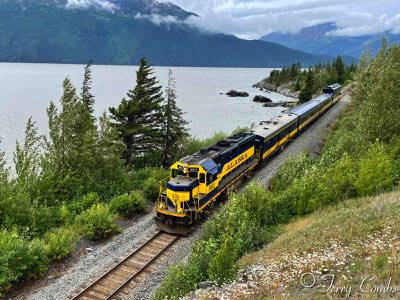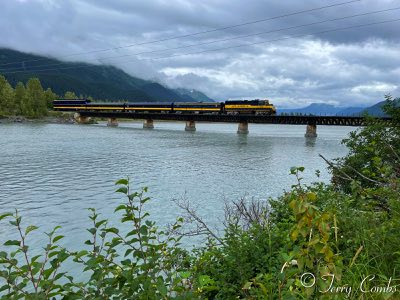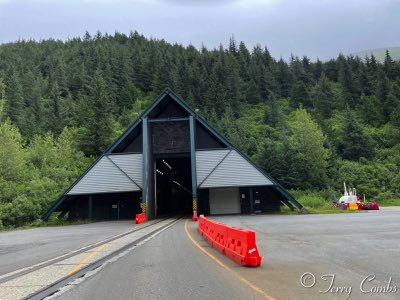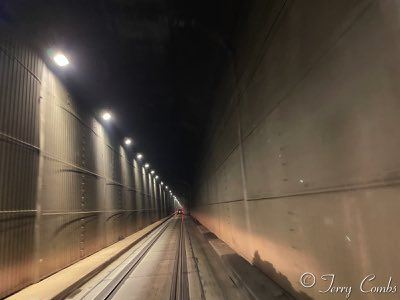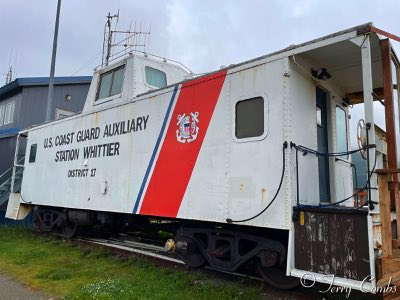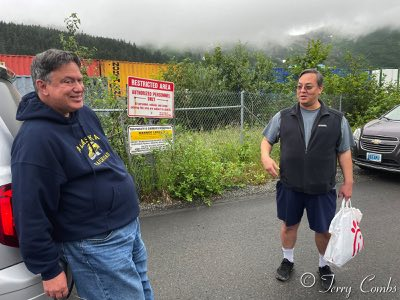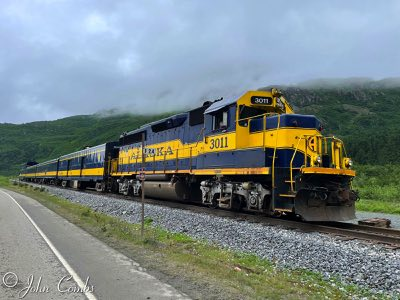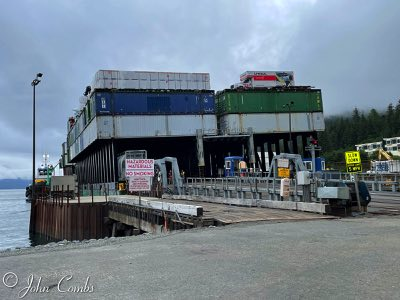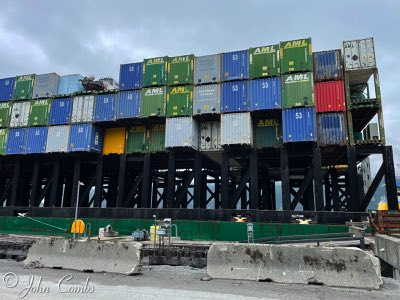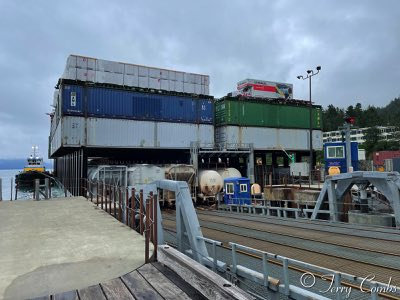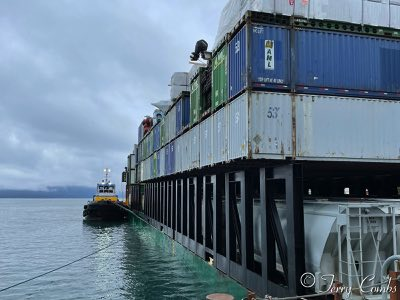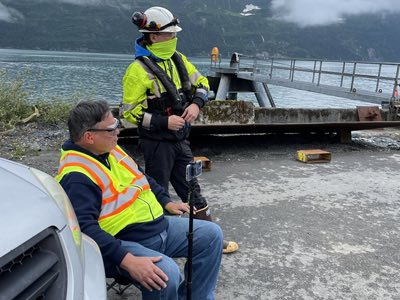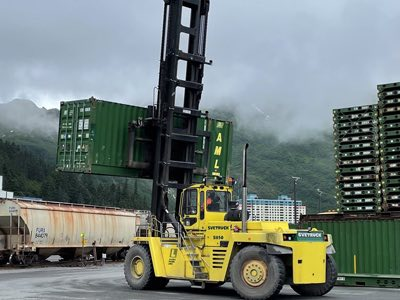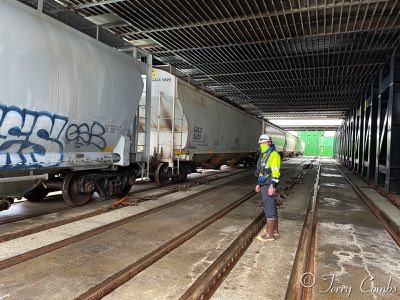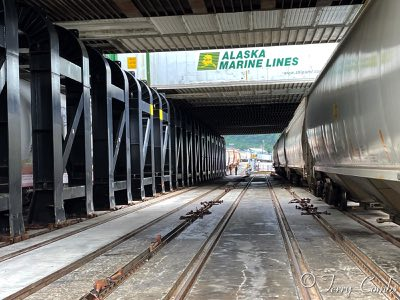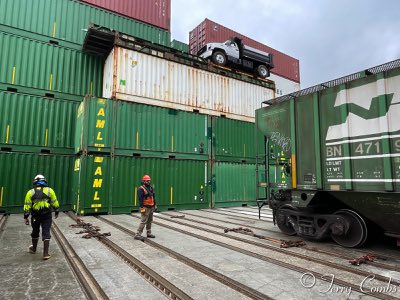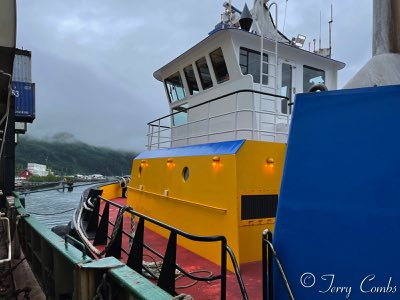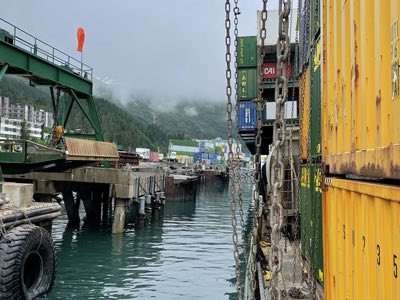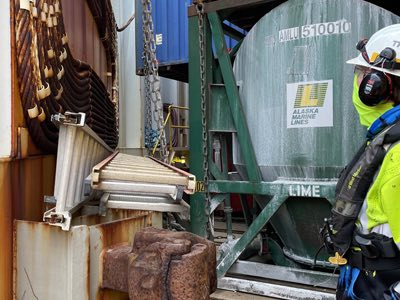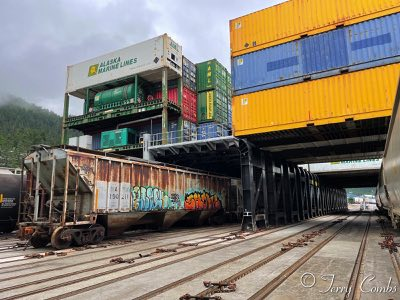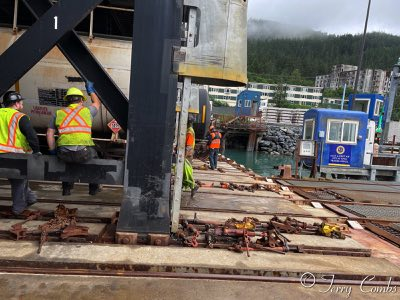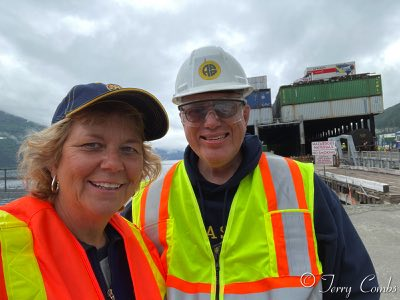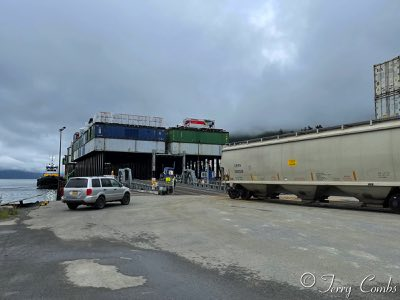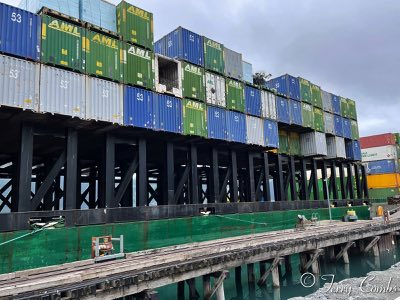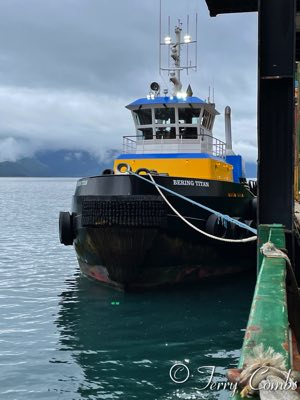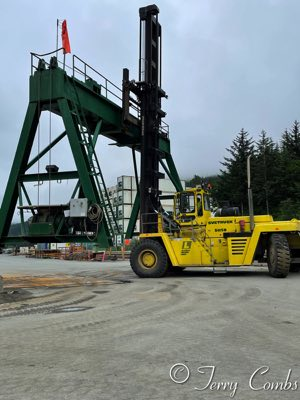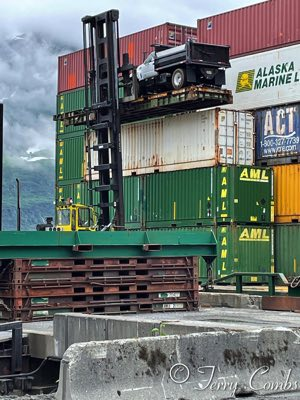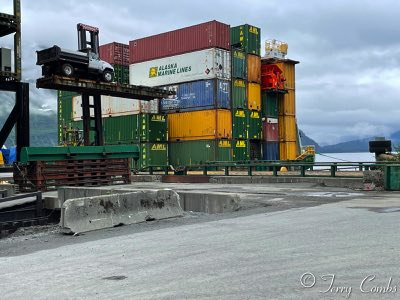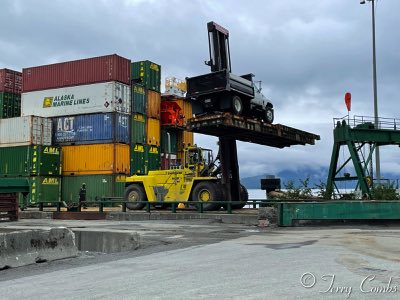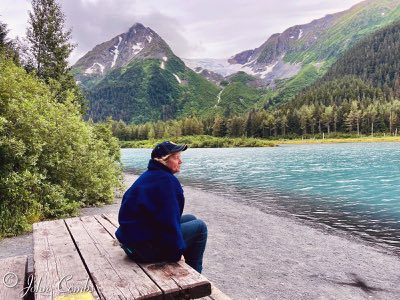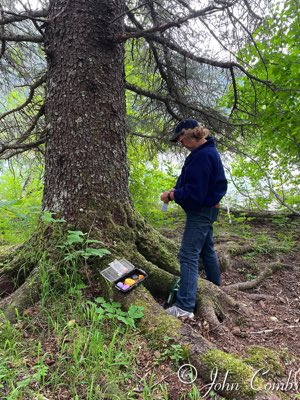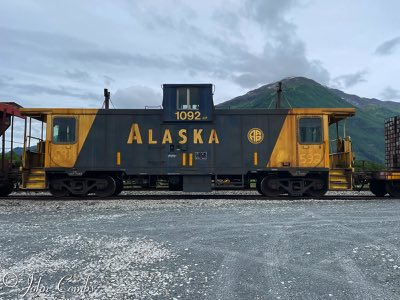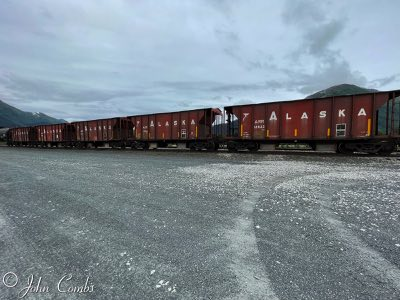Wednesday, July 28, 2021
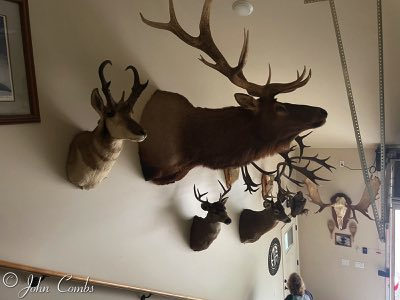 Every time Terry and I walked up or down the garage stairs leading to the Rudd's guest apartment, I would gaze upon the many taxidermy mounts above my head. Some of these come from hunting trips outside of Alaska. I figure there will come a day where I'd see the head of Bantha or Rancor mounted as well.
Every time Terry and I walked up or down the garage stairs leading to the Rudd's guest apartment, I would gaze upon the many taxidermy mounts above my head. Some of these come from hunting trips outside of Alaska. I figure there will come a day where I'd see the head of Bantha or Rancor mounted as well.
Terry and I passed underneath those taxidermy mounts at 10:00 a.m. to head out the door to drive to Whittier to watch the barge unloading. We could've started a smidge later, but I wanted to catch a train or two enroute.
My sources confirmed the Glacier Discovery was running on time, so we set up our first shot at the bridge near Bird Creek. I had barely set up the tripod when the train emerged from around the corner. Oh snap! I got the video, but not by much. Check out the video here.
Continuing down Turnagain Arm, we caught the the Glacier Discovery at TwentyMile, which is my all time favorite spot south of Anchorage. You'll find the video for it here. We also caught this train at Bear Valley and Whittier tunnel. Click here to see the video of the Glacier Discovery at the Whittier Tunnel.
The Anton Anderson Memorial tunnel is the longest combined vehicle-railroad tunnel in North America, covering a distance of 2.6 miles through Maynard Mountain. Prior to the summer of 2000, it was solely used by rail traffic. An $80 million retrofit created a combined single unidirectional highway lane and single-track railway. Vehicles travel through the tunnel at 25 miles per hour while remaining 35 feet apart and the journey typically takes ten minutes from end to end. Click here to see a very well done YouTube video of traveling through the Whittier tunnel.
We caught the 12:30 p.m. Whittier tunnel entry and arrived in time to stumble upon a trio of freight switching engines, GP40 numbers 3005, 3003 and 3006. Here are a couple of videos to enjoy (1, 2).
On May 27, 2019 our home was struck by a tornado and our property lost 53 trees 23 of which were large mature ones. Part of our home was damaged by the twister, but was quickly repaired through our insurance company. Unfortunately the fierce winds uprooted several of our favorite trees which were irreplaceable. One of them was a forked cedar tree which rested on the east side of our pond. The tornado totally uprooted it. One of my Alaska friends, Robert Krol, offered to make ink pens from the wood by turning them on a lathe. We cut some of the straight branches from the cedar and shipped them to Robert. The pens were absolutely beautiful, and my kids quickly snatched them up. Robert volunteered to make more, so we bagged up more cedar branches and put them in our Alaska bound suitcase.
As Robert was in Whittier today, we arranged a last minute meet up to give him the wood before the barge unloaded. Robert pulled up and met us at the security gate just before our 1:30 p.m. entry slot. After talking for a few minutes, we gave him the bag of cedar wood and he presented Terry with a red pen made from a blank cartridge on the lathe. You can view a photo of her red pen and one of the cedar tree pens here.
Transport Sector Manager A.J. Washburn met us promptly at the security gate and took us to a nearby building to grab our safety equipment. Next, the employees (contracted by AML) gathered around for a safety briefing which included a weather report, barge track unloading sequence, yard conditions, potential hazards, tide activity, personal protection equipment, emergency information and the rule of the week. The tugboat used to bring the barge to port was the Bering Titan under the command of Captain McGavic. You can learn more about these tugboats here.
A.J. Washburn took Terry and I out to the barge to watch the unloading process. The Alaska Railroad takes safety very seriously, and A.J decided to put me in a location which would provide for maximum protection. As long as I didn't stray more than a couple of feet from that location, I could shoot photos and video to my hearts content. Terry, on the other hand, was afforded the privilege of getting a closer look while still remaining in safe zones.
The barge can hold over 50 railcars on the first level and over 100 trailer containers upstairs. To prepare for barge unloading, steel cables are connected from winches stationed on the dock to the barge. Winches are then used to pull the cables left or right until the rails on the barge are aligned with those on the dock. Once this occurs, a temporary connection is put in place. Now railcar freight can be unloaded. Today's head yard goat was #3006. In front of the yard goats are several flat cars known as idler flats. What is an idler flat? I'm glad you asked. The joint between the barge and the dock is very weak. In order to avoid losing freight or locomotives, old flat cars are used to serve as a connector between the two. Flat cars work best for the task since they are lightweight and do not block visibility Today they added two hoppers in front of the idler flats.
We watched the entire unloading of all the railcars and even took in the unloading of a few items from the top rack.
Would you like to see the entire unloading of the barge? Here are the videos:
- Idler freight
- Unloading the first cut of railcars (covered hoppers)
- Pushing the first cut of railcars onto the barge to link with the next cut
- Unloading the next railcar cut
- Stacking containers in the yard
- Truck brings in containers and forklift unloads them
- Forklifts getting empty containers ready for return on the barge plus pushing the cut of cars onto the barge for the next cut
- Unloading another cut with close supervision of a bulkhead flatcar
- Pushing the consist to unload the next string
- Let's rock and roll - removing the next cut of railcars
- After checking out an issue the railcars are now removed from the barge
- More from the Container Movement Ballet
- Truck dumping coal in the yard
- Winches pulling steel cables to move the barge to unload two additional tracks
- Unloading another cut of railcars
- Unloading another string of cars - BNSF covered hopper, TILX tank and covered hopper railcars
- Pushing the consist to unload the next string
- Unloading a series of tank cars
- Unloading the final string of railcars
- Forklift unloading a truck from the top rack of the barge
- Bonus video #1: Watching the crew connect air hoses, etc. on a string of cars
- Bonus video #2: View from the barge of the unloading of a string of cars
- Bonus video #3: A.J. Washburn uses the controller to move the barge to unload additional tracks
We thanked A.J. for taking such good care of us during our visit. As we departed the loading dock, we had some extra time before the next tunnel opening, so we grabbed the five remaining geocaches I had not yet found in Whittier. With five more "found its" in the books we queued up in lane #1 to leave Whittier. Again, luck was with us as we spotted and photographed the Glacier Discovery at the tunnel's entrance.
Exiting the tunnel,Terry immediately checked for surrounding geocaches. We grabbed a dozen more on the way back, some of which took us to some extremely scenic locations. This is one of the true benefits of geocaching!
The Portage siding contained a work train tied up for the night, and we grabbed a few photos. Five of the old 70 ton MK ballast hoppers were there. These 1953 hoppers had outlived their useful lives, and now are only used for instate Maintenance of Way service.
Returning to the Rudd's home, we once again passed under the taxidermy mounts. I decided not to look up and greet any of them. Maybe sometime it is better not to look up.
